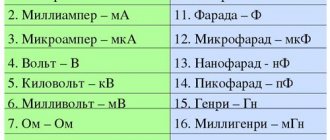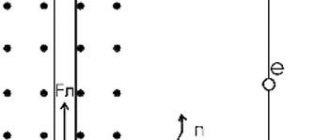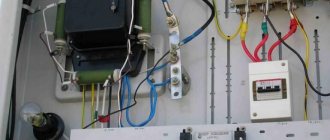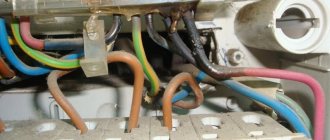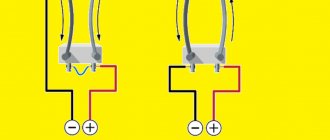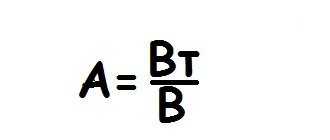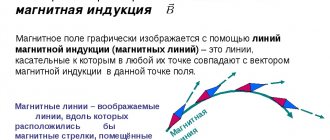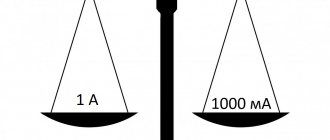- home
- Directory
- Laws
- Ampere's law
- Ampere's law
- The meaning of Ampere's law
Ampere's law shows the force with which a magnetic field acts on a conductor placed in it. This force is also called the Ampere force.
Ampere was the first to establish that conductors through which electric current flows interact mechanically (attract or repel).
The force acting on a current-carrying conductor in a magnetic field is called the Ampere force. Its designations are: \( \overrightarrow{F} \),\( \overrightarrow{F}_{A} \). The force (\( \overrightarrow{F} \)), which acts on a straight conductor with current (I), is always perpendicular to the conductor and the direction of the magnetic induction vector (\( \overrightarrow{B} \)). If a straight conductor is located parallel to the direction of the magnetic field lines, the field does not act.
The specific direction of the Ampere force can be found using the left-hand rule. The left hand must be positioned so that the field lines enter the palm, the four fingers are directed along the current, then the thumb bent 90 degrees will indicate the direction of the Ampere force.
Ampere also established that two parallel conductors with current attract if the currents have the same directions and repel if the currents flow in opposite directions. This is easy to explain if you imagine that one conductor creates a magnetic field, and another conductor is placed in it and this field acts on it. You can use the left hand rule and figure out which way the force is directed.
What are volts, amperes and watts
Volt is a measuring unit of electropotential, electrical voltage and electromotive force. It is considered the amount of electrical voltage at the conductor end that is necessary to generate heat with a power of 1 W with a constant electric current flowing through the conductor element equal to the amperage.
The ampere is considered a unit of electrical current in the international system, or the force of electric current penetrating through a conductor element in the amount of one coulomb per second.
Watt is a power measurement unit, as well as heat flux, sound energy flux, active and total power of alternating electric current. These are all scalar units of measurement in the international system.
Note! Special formulas are used to calculate them. So, to find the electrical voltage measured in volts, it is necessary to divide the electric field by the charge moving along the electrical circuit section. To find the electric current, you need to divide the voltage by the conductor resistance, and to find the power you need to multiply the voltage by the current force or double the current value by the resistance. It is also possible to divide the double voltage value by the resistance.
Using infinitesimals
In the above formulas, infinitesimal quantities (dF, dl) are used. Their use expands the possibilities for calculating parameters. Usually relatively simple situations are studied experimentally, but in this case there is a need to obtain formulas of a universal nature.
In real life, for example, situations are possible when the magnetic field strength changes according to a complex law or the contours of conductors of arbitrary configuration are considered.
The use of infinitesimal quantities makes it possible to generalize the results of fundamental experiments to a wide variety of situations. For this purpose, methods of differential and integral calculus can be applied.
When considering an infinitesimal section of wire, we are talking about a quantity that is small enough to be considered straight. In this case, it is possible to apply already existing patterns. Using integration methods, you can move on to wires that have a contour of varying degrees of complexity or to consider a magnetic field of complex configuration.
Calculating amperage, knowing power and voltage
You can find out the amount of electric current through power and voltage by dividing the second by the first. To make it easier to count, you can use milliamps and kilowatts. There is also a formula in which you need to divide the voltage by the resistance or the power by the resistance, and then calculate the square root of the resulting sum. It is worth pointing out that today you can use a special online calculator, where you only need to substitute known scalar measuring quantities.
What conclusions can be drawn
Both ampere and kilowatt or watt can be called very important, in fact, irreplaceable values in electrical engineering. If there are devices on which values are indicated in one of these units, there are those that are marked using other measurement values. Marking on electrical appliances using these values is mandatory, since it allows everyone to choose the necessary device. If you need to convert amperes to kilowatts, then you can safely use a ready-made table or a physical formula known from school.
Anyone can complete the conversion process correctly and quickly, because the calculation formula is quite simple. The main thing is to carry out the correct mathematical operations with the values used and the result will definitely be accurate. Using a special formula, you can convert not only amperes to kilowatts, but also vice versa, because the value of this unit may also be in demand in some cases.
This way, simply and without problems, everyone can cope with the task and get the highest quality result.
So it’s worth thinking about the fact that studying physics at school is quite useful, because it can really be useful in everyday life, and for absolutely everyone. It is worth remembering simple formulas from school so that when you have to convert amperes to kilowatts, you can quickly complete this task and forget about it by installing the required electrical component. No tags for this post.
How many amps does the device consume?
When answering the question of how to find out amperes, it is worth pointing out that this can be done using a device called an ammeter, as well as how to calculate watts knowing volts and amperes. With a simple single measurement, you can not only find out the amount of energy consumed, but also convert the resulting value into other values, adjust the wiring layout, buy a more powerful electric meter, and more. You can also find out this information by opening the instruction manual.
Note! Often, all the necessary data is written on the box itself or the technical specifications on the manufacturer’s website. Often the information is indicated in kW and can easily be converted to amperage using a converter. Another easy way to determine energy consumption and amperage is to examine the consumer's electric meter or circuit breaker. But, in this case, it is necessary to connect only one device to the network.
Otherwise, it will be almost impossible to find out and calculate these electricity indicators. It is interesting that in new models of electricity meter, such information takes place about each connected device in the network.
According to the formula or even simpler
We choose two things in the store that should be used “in tandem”, for example, an iron and a socket, and suddenly we are faced with a problem - the “electrical parameters” on the label are indicated in different units.
How to choose instruments and devices that suit each other? How to convert amps to watts?
Related but different
It must be said right away that a direct conversion of units cannot be done, since they represent different quantities.
Watt - indicates power, i.e. the rate at which energy is consumed.
Ampere is a unit of force that indicates the speed at which current flows through a specific section.
To ensure trouble-free operation of electrical systems, you can calculate the ratio of amperes and watts at a certain voltage in the electrical network. The latter is measured in volts and can be:
- fixed;
- permanent;
- variables.
Taking this into account, a comparison of indicators is made.
How to convert milliamps to watts
Milliamps is a sub-value equal to 0.001. So, in one A there is 1000 mA. You can convert values using the available numbers using a calculator or by multiplying by the given value. For example, to calculate how much 0.7 A will be in mA, you need to multiply 0.7 by 1000. The result will be 70 mA.
As for using the calculator, you need to insert the initial indicators into the appropriate fields and press the button. This system can be used when there are large numbers.
Converting time units
From previous lessons we know that the basic units of time are:
- seconds
- minutes
- watch
- day
Any quantity that characterizes time can be converted from one unit of measurement to another. For example, 15 minutes can be converted into seconds, hours, or days.
In addition, when solving problems in physics, it is imperative to comply with the requirements of the international SI system. That is, if time is given not in seconds, but in another unit of measurement, then it must be converted into seconds, since the second is a unit of time in the SI system.
To convert time from one unit of measurement to another, you need to know what a particular unit of time consists of. That is, you need to know that, for example, one hour consists of sixty minutes or one minute consists of sixty seconds, etc.
Let us show with a simple example how to reason when converting time from one unit of measurement to another. Let's say you want to convert 2 minutes to seconds.
Since we are converting minutes to seconds, we first need to find out how many seconds are contained in one minute. There are sixty seconds in one minute:
1 min = 60 s
If in seconds, then how many seconds are there in two such minutes? The answer suggests itself - 120 seconds. And these 120 seconds are obtained by multiplying 2 by 60. This means that to convert 2 minutes into seconds, you need to multiply 2 by 60
2 × 60= 120 s
Now let's try to convert the same 2 minutes into hours. Since we are converting minutes to hours, we first need to find out how many minutes are contained in one hour. One hour contains sixty minutes:
1 hour = 60 m
If one hour contains 60 minutes, then an hour that contains only 2 minutes will be much less. To get it you need to divide 2 minutes by 60
When dividing 2 by 60, the resulting periodic fraction is 0.0 (3). This fraction can be rounded to the hundredths place. Then we get the answer 0.03
2: 60= 0.03h
When converting time units, a diagram is also applicable that makes it easier to figure out whether to use multiplication or division:
For example, let's convert 25 minutes to hours using this scheme.
So we have to go from minutes to hours. In other words, move from a lower unit of measurement to a higher one (hours are older than minutes). We look at the diagram and see that the arrow indicating the transition from lower to higher units is directed upward and at the end of the arrow it is indicated that we must apply division:
Now you need to find out how many minutes are in one hour. One hour contains 60 minutes. And an hour that contains only 25 minutes will be much less. To find it, you need to divide 25 by 60
When dividing 25 by 60, the resulting periodic fraction is 0.41 (6). This fraction can be rounded to the hundredths place. Then we get the answer 0.42
25:60 = 0.42 h
How to convert Watts to Ohms
Today, it is not difficult to find a convenient transfer convector. There are many of them on the network and each of them works in automatic remote mode. All the user needs to do is enter the requested numbers before starting to connect the equipment to the network. It is worth pointing out that there are different convectors. Some convert these watts, and some directly into ohms. You can convert watts to ohms without its help using the simple example given below.
In general, in order to find out the necessary data, you need to use the above formulas or use an online convector for this work. These measurement values will help you calculate the energy used by a specific device and make other calculations in the electrical field.
Calculation table
To convert amperes to kilowatts or vice versa, there is a special table. Using it, you can quickly and without any problems find the desired value.
The calculation table looks something like this:
Using this table, you can easily take the necessary measurements and determine the value required for specific purposes.
It is important! To convert these two quantities into one another, the user needs to know at what voltage this or that device operates, because without this it is impossible to perform correct calculations. But before translating these meanings, you need to know what each of them specifically means.
So, amperes are a unit of measurement of the force that an electric current has, and kilowatts measure power. These indicators must be known when selecting appropriate protective or other electrical equipment for use
But before translating these meanings, you need to know what each of them specifically means. So, amperes are a unit of measurement of the force that an electric current has, and kilowatts measure power. It is necessary to know these indicators when selecting appropriate protective or other electrical equipment for use.
Current calculation
The current value is calculated by power and is necessary at the design (planning) stage of a dwelling - apartment, house.
- The choice of power cable (wire) through which power consumption devices can be connected to the network depends on the value of this value
- Knowing the voltage of the electrical network and the full load of electrical appliances, you can use the formula to calculate the strength of the current that will need to be passed through the conductor (wire, cable). The cross-sectional area of the cores is selected based on its size.
If the electrical consumers in the apartment or house are known, it is necessary to perform simple calculations in order to correctly install the power supply circuit.
Similar calculations are performed for production purposes: determining the required cross-sectional area of the cable cores when connecting industrial equipment (various industrial electric motors and mechanisms).
Necessary calculations
First you need to check the sockets that are connected to the selected machine. Sometimes an automatic device powers not only household appliances, but also lighting devices. If the electrical wiring in the house is not installed correctly, the entire supply may depend on only one device. They count the total number of consumers and add up the voltage they need to operate.
The result will be the sum of watts that the automatic device supplies to these devices. Most likely, the equipment will not be connected at the same time, but the formula will make it possible to calculate the maximum voltage consumption. If some device does not indicate a specific power, but its interval, then it is necessary to take the largest value.
Minimum values are not taken into account, since in this case the machine will operate at full load. This is unacceptable, because there are interruptions in the network, and this will lead to breakdown of the disconnecting device. The voltage in private homes and in industrial enterprises is different. There are two types:
- single-phase network - 220 V;
- two-phase - 380 volts.
Single-phase network voltage 220 V
Current strength I (in amperes, A) is calculated using the formula:
I=P/U,
where P is the electrical full load (must be indicated in the technical data sheet of the device), W (watt);
U – voltage of the electrical network, V (volts).
The table below shows the load values of typical household electrical appliances and the current they consume (for a voltage of 220 V) .
| electrical appliance | Power consumption, W | Current strength, A |
| Washing machine | 2000 – 2500 | 9,0 – 11,4 |
| Jacuzzi | 2000 – 2500 | 9,0 – 11,4 |
| Electric floor heating | 800 – 1400 | 3,6 – 6,4 |
| Stationary electric stove | 4500 – 8500 | 20,5 – 38,6 |
| microwave | 900 – 1300 | 4,1 – 5,9 |
| Dishwasher | 2000 — 2500 | 9,0 – 11,4 |
| Freezers, refrigerators | 140 — 300 | 0,6 – 1,4 |
| Electric meat grinder | 1100 — 1200 | 5,0 — 5,5 |
| Electric kettle | 1850 – 2000 | 8,4 – 9,0 |
| Electric coffee maker | 6з0 — 1200 | 3,0 – 5,5 |
| Juicer | 240 — 360 | 1,1 – 1,6 |
| Toaster | 640 — 1100 | 2,9 — 5,0 |
| Mixer | 250 — 400 | 1,1 – 1,8 |
| Hairdryer | 400 — 1600 | 1,8 – 7,3 |
| Iron | 900 — 1700 | 4,1 – 7,7 |
| Vacuum cleaner | 680 — 1400 | 3,1 – 6,4 |
| Fan | 250 — 400 | 1,0 – 1,8 |
| TV | 125 — 180 | 0,6 – 0,8 |
| Radio equipment | 70 — 100 | 0,3 – 0,5 |
| Lighting devices | 20 — 100 | 0,1 – 0,4 |
The figure shows a diagram of the power supply device for an apartment with a single-phase connection to a 220 V network .
As can be seen from the figure, various electricity consumers are connected through corresponding machines to an electric meter and then to a general machine, which must be designed for the load of devices with which the apartment will be equipped. The wire that supplies power must also satisfy the load of energy consumers.
Below is a table for hidden wiring with a single-phase apartment connection diagram for selecting wires at a voltage of 220 V
| Wire core cross-section, mm 2 | Conductor core diameter, mm | Copper conductors | Aluminum conductors | ||
| Current, A | Power, W | Current, A | power, kWt | ||
| 0,50 | 0,80 | 6 | 1300 | ||
| 0,75 | 0,98 | 10 | 2200 | ||
| 1,00 | 1,13 | 14 | 3100 | ||
| 1,50 | 1,38 | 15 | 3300 | 10 | 2200 |
| 2,00 | 1,60 | 19 | 4200 | 14 | 3100 |
| 2,50 | 1,78 | 21 | 4600 | 16 | 3500 |
| 4,00 | 2,26 | 27 | 5900 | 21 | 4600 |
| 6,00 | 2,76 | 34 | 7500 | 26 | 5700 |
| 10,00 | 3,57 | 50 | 11000 | 38 | 8400 |
| 16,00 | 4,51 | 80 | 17600 | 55 | 12100 |
| 25,00 | 5,64 | 100 | 22000 | 65 | 14300 |
As can be seen from the table, the cross-section of the cores depends, in addition to the load, on the material from which the wire is made.
Three-phase network voltage 380 V
With a three-phase power supply, the current strength I (in amperes, A) is calculated by the formula:
I = P /1.73 U,
where P is power consumption, W;
U—mains voltage, V,
since the voltage in a three-phase power supply circuit is 380 V, the formula will take the form:
I = P /657.4.
If a three-phase power supply with a voltage of 380 V is supplied to the house, the connection diagram will look as follows.
Electricity
For simplicity, electrical parameters are often explained using the example of water moving through pipes. This term, expressed in amperes (A), denotes the speed of movement of electrons in a conductor. Obstacles to liquid are created by the small size and distance of the transport system. Resistance to electric current is influenced by:
- presence of free electrons, chemical purity of the material;
- cross-sectional area (length) of the wire;
- temperature conditions.
How to calculate the number of amperes in the network
In practice, different calculation schemes are used. In particular, they use automated programs (calculators). Such tools are offered free of charge by specialized websites online. Below are formulas and examples that will help you calculate electrical parameters yourself.
How to find out the current, knowing the power and voltage
The DC power source (battery) provides an output voltage of 12 Volts. The known power consumption is 2 W. How to calculate amperage is shown in the example:
For your information. For convenience, fractional and multiple values are used in practice. In this example, 167 mA (milliamps).
How to find out voltage by knowing current strength
The above shows how to calculate amperes, knowing the power and voltage. The same formula is used for the reverse action. If the current is 200 mA, with a power of 2 W at the measurement points, the device will display the following voltage:
U = P/I = 2/0.2 = 10 V.
How to calculate power knowing current and voltage
The result can be calculated using the following example:
P = I*U = 0.2 * 10 = 2 W.
On the left side of the figure is the formula for calculating mechanical power:
- A – useful work in Joules;
- t – time period for which this operation was performed.
How to determine the power of a circuit with a resistance tester
In real conditions, the electrical resistance of the conductor has a significant influence. By selecting the appropriate mode, you can find out the actual value using a multitester. The switch is set to a position that corresponds to a certain range. They move from large values to small ones until an indication appears on the screen.
When R = 20 Ohm, knowing the current strength I = 200 mA, the power is calculated using the following formula:
P = I2*R = 0.04*20 = 0.8 W.
If necessary, specify the voltage:
Why do you need current calculation?
To calculate amperes by power for AC networks with reactive loads, appropriate corrections are needed. Such consumers shift the current vector by 90° forward (backward) with respect to the voltage with capacitive (inductive) characteristics, respectively.
Current calculation for a single-phase network
The change in current, voltage and power according to a sinusoidal graph explains the meaninglessness of measuring instantaneous values. The parameters are calculated taking into account time intervals. As a rule, the full period of one oscillatory cycle is used.
A generator with a significant value of the reactive component will perform its functions less efficiently. In this case, part of the power will not perform useful work.
Current calculation for a three-phase network
This option can be represented as a combination of several single-phase networks. When represented by vectors on the complex plane, a phase shift of 120° will be visible.
The figures show a voltage of 220 V in each phase and a linear value of 380 V. You should pay attention to the current in the neutral conductor (I0), which does not perform useful functions. It is created due to the uneven distribution of connected loads.
How to calculate current power
To correct inductive (capacitive) components, an extended calculation formula is used:
In the absence of such loads, an additional factor is taken equal to one.
This ampere table will help you select the appropriate circuit breaker (fuse) taking into account the parameters of the connected equipment.
Dependence of current on power consumption
| Rated current of the protective device, A | Power consumption (kW) for the network | |
| Single phase | Three phases | |
| 2 | 0,4 | 1,3 |
| 6 | 1,3 | 3,9 |
| 16 | 3,5 | 10,5 |
| 25 | 5,5 | 16,4 |
How to convert watts to amperes
To connect the electric motor, you need to take the cos ϕ value from the accompanying documentation. This data is duplicated in a special tag attached to the case. How to calculate amperes for a three-phase network is shown by the following formula:
Closed Loop Effect
Using Ampere's law, we can draw a conclusion about what the magnetic field of a closed loop will be. For example, you can vertically orient a frame in a field whose field lines are directed from top to bottom.
To determine which direction the magnetic induction will have in this situation, you should also use the left-hand rule. Since the current in the lower part of the frame is directed to the right, the hand must be positioned so that the fingers are directed, if you look at the drawing, also to the right. In this case, the palm should be open upward. The thumb in such a situation will be directed away from the observer.
Applying this rule to the top of the frame, one can see that the Ampere force acts towards the observer. That is, the frame is given a rotational movement. However, as you approach the horizontal position, this force decreases.
If the frame has inertia and thanks to it it slips past the horizontal position, then the forces described above will begin to act again: weakly at first, and then will increase as the frame reaches a vertical position.
